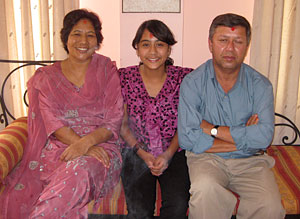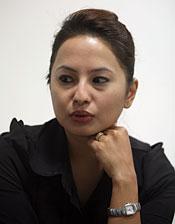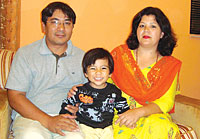 MOSAIC: Village-wise ethnic distribution of Nepal. |
Bahuns are marrying Newars, Rais are marrying Chhetris, Pahadis are marrying Madhesis like never before. With greater mobility, education and rising living standards, Nepali families are becoming a mongrel nation in the best possible sense.
 KIRAN PANDAY The Poudyal-Dali family at their home in Putali Sadak. |
Divisive ethnic politics may have forced us to be cynical about integration, but multicultural families prove that coexistence is not just possible, but necessary, in a country like Nepal with its rich ethnic diversity.
Yuki Poudyal (right), daughter of a Newar mother and a Bahun father, has got used to being questioned about her Brahmin surname and strikingly Newari facial features. "I have the best of both worlds," she says, "it doesn't bother me anymore when people ask me if I am Newar because that is also very much a part of my heritage."
Explains Yuki's brother Ananta: "Maybe because in the family we get to interact with people from both communities we get to see how similar we are, and not how different."
Yuki's father, Shambhu, says the family has managed to break through ethnic stereotypes. "Our family was built around values other than caste or ethnicity, so it was natural for the children to be less hung up about them," he says.
 |
The best part of having a multicultural background for Pravat J. Gurung is celebrating festivals of both sides of his family. "I am both a Gurung and a Rana," says Pravat.
Keeping a balance between two cultures is sometimes difficult, but Niharika's mother Sandhya has managed it for over two decades now. She has kept her maiden name, follows Newari and Brahmin traditions with equal zest and celebrates festivals of both sides.
 |
Inter-ethnic marriages are now becoming so common that some extended families now look like Nepal in a microcosm. Malvika Subba (right), former Miss Nepal and daughter of a Bahun mother and a Limbu father, knows this well. Her brother has married a Newar who is a half-Newar, half-Thakuri. Another brother has married a Chettri. Malvika has Tamang, Tibetan, Gurung and even Singaporean Chinese to count among her relatives.
Says Malvika: "I love my rainbow family. If such diverse people can live under one roof, there is no reason why communities can't live in peace."
Across generations
 |
When it comes to living with multiple identities, few people know it better than Rashmi Shah Prajapati (left) . Her father is a Thakuri, mother a Rai, and is herself married to a Newar. Rashmi's mother was born from an inter-ethnic union as well, from a Chettri mother and a Rai father, both of whom spoke fluent Maithili, having spent their lifetime in Janakpur. When asked what her roots are, Rashmi replies without hesitation: "Nepali."
Who am I?
 |
When tensions flared between Madhesis and Pahadis, Kalpana Singh(left) must have asked herself: "Who am I?" Her mother is a Pahadi Bahun and father a Madhesi, and her village in the Tarai is home to many Tamang families. She speaks with her Tamang friends in Maithili and converses with her Newar aunt in Nepali. Her Madhesi grandfather teaches Nepali in the village school.
Sangita Singh who married Kalpana's uncle is a Newar from Butwal, which falls under a proposed federal province of the Magars. She now lives in Kathmandu, which is claimed by both Newars and Tamangs. Asks Sangita: "If Nepal becomes an ethnic federation, where do we belong?"
READ ALSO:
Nepal goes overseas, DAMBAR KRISHNA SHRESTHA
Caste no bar, KONG YEN LIN
Happily ever after, SRADDHA BASNYAT


